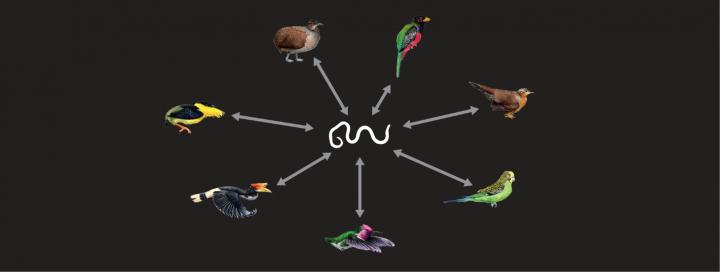
The researchers found DNA 'fossils' of parasitic nematodes in seven groups of birds (clockwise): trogons, mesites, parrots, hummingbirds, hornbills, manakins, tinamous. In rare instances, DNA is known to have jumped from one species to another. If a parasite's DNA jumps to its host's genome, it could leave evidence of that parasitic interaction that could be found millions of years later -- a DNA 'fossil' of sorts. An international research team led from Uppsala University has discovered a new type of so-called transposable element that occurred in the genomes of certain birds and nematodes.
The results are published in Nature Communications.
Dr. Alexander Suh at Uppsala University is an expert on the small stretches of DNA that tend to jump from one place to another, called transposable elements. Working with a team from eleven institutions in five countries, the researchers discovered a new type of transposable element that occurred in certain bird genomes but not others.
By searching DNA databases, the team discovered that the only other animals that shared the new transposable element were nematode worms that are parasites of humans and other mammals.
'This finding was so unexpected that we were literally speechless at first,' says Alexander Suh.
By comparing the DNA sequences of each instance of the transposable element, Suh and his team were able to figure out that the transfer of DNA between nematodes and birds occurred in two waves across the entire tropics, including remote places like Madagascar. They involved charismatic groups of birds such as parrots, hummingbirds, manakins.
Certain human diseases, such as avian flu and HIV/AIDS, are known to have jumped onto our species from animal hosts. Epidemiologists have only recently realized the importance of these so-called 'zoonoses'. However, there are many more human diseases whose host-origins are unknown. These include lymphatic filariasis and loiasis, two serious human tropical diseases that are caused by nematode worms and spread by mosquitoes. The present study reveals that these modern human parasite species were parasites of birds from at least 25-17 million years ago. They probably did not infect mammals at the time that the transposable element was actively jumping between species, because there is no trace of it in mammal genomes. The genomes show that the bird parasites were widespread because they infected different bird groups that occurred in each of the world's major tropical regions and would have been isolated from each other at the time.
Genome sequences continue to reveal evolutionary history in surprising ways. Not only can comparisons of genomes assess relatedness, but interactions between specific host and parasite species can also be permanently recorded in the genome via jumping of transposable element DNA from one to the other. In this first example of that phenomenon in birds and nematodes, we learned that a class of parasites that is a present-day scourge once switched hosts from birds to mammals -- a process that is all too familiar to modern epidemiologists.
Source: Uppsala University
 Print Article
Print Article Mail to a Friend
Mail to a Friend
